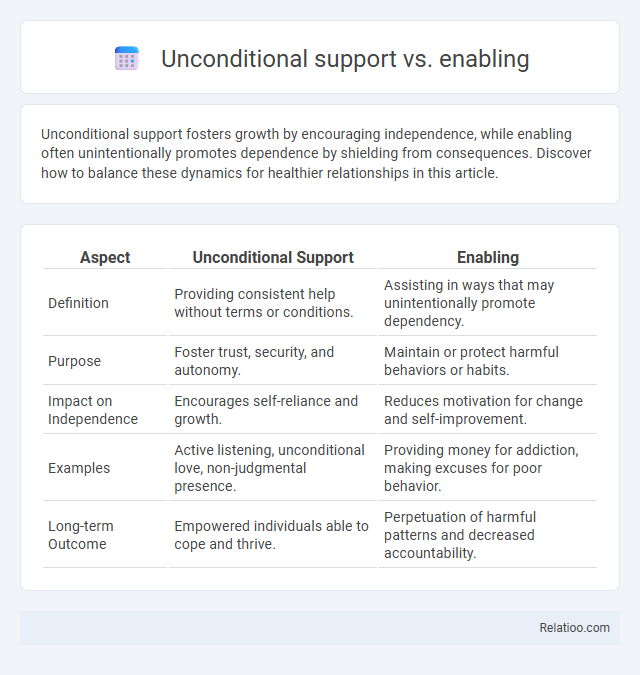Unconditional support fosters growth by encouraging independence, while enabling often unintentionally promotes dependence by shielding from consequences. Discover how to balance these dynamics for healthier relationships in this article.
Table of Comparison
| Aspect | Unconditional Support | Enabling |
|---|---|---|
| Definition | Providing consistent help without terms or conditions. | Assisting in ways that may unintentionally promote dependency. |
| Purpose | Foster trust, security, and autonomy. | Maintain or protect harmful behaviors or habits. |
| Impact on Independence | Encourages self-reliance and growth. | Reduces motivation for change and self-improvement. |
| Examples | Active listening, unconditional love, non-judgmental presence. | Providing money for addiction, making excuses for poor behavior. |
| Long-term Outcome | Empowered individuals able to cope and thrive. | Perpetuation of harmful patterns and decreased accountability. |
Understanding Unconditional Support
Understanding unconditional support means offering your help without conditions while fostering independence and growth, unlike enabling, which can inadvertently promote dependency by shielding from consequences. Unconditional support empowers you to provide consistent encouragement, helping others develop resilience and self-reliance without compromising boundaries. Recognizing the difference ensures your support nurtures positive change rather than perpetuating harmful patterns.
What Does Enabling Behavior Look Like?
Enabling behavior often involves consistently rescuing someone from the natural consequences of their actions, such as making excuses or taking over responsibilities that hinder their personal growth. Unlike unconditional support, which offers encouragement without judgment or interference, enabling can perpetuate dependency and prevent accountability. Understanding these distinctions helps you provide support that fosters independence rather than dependency.
Key Differences Between Supporting and Enabling
Unconditional support involves providing consistent encouragement and resources that empower your loved ones to grow independently, while enabling typically means shielding them from the consequences of their actions, which can hinder personal responsibility. Key differences lie in setting healthy boundaries and promoting accountability through unconditional support, as opposed to enabling behaviors that may foster dependency. Understanding these distinctions helps you offer meaningful assistance that encourages resilience rather than reliance.
Emotional Impact on Relationships
Unconditional support fosters a safe emotional environment where Your loved ones feel valued without judgment, strengthening trust and intimacy. Enabling, however, often undermines emotional boundaries by encouraging dependency, which can lead to frustration and resentment in relationships. Differentiating these behaviors helps maintain healthy connections and promotes genuine emotional growth.
Spotting the Signs of Enabling
Unconditional support involves offering consistent encouragement without judgment, while enabling occurs when help inadvertently protects harmful behaviors, delaying personal responsibility. Spotting the signs of enabling includes noticing patterns such as making excuses for someone's actions, taking on their responsibilities, or preventing natural consequences. Recognizing these behaviors is crucial to shift from enabling to providing healthy, unconditional support that promotes growth and accountability.
Healthy Boundaries in Supportive Relationships
Unconditional support in supportive relationships involves offering consistent care without setting limits, while enabling allows harmful behaviors to persist by removing natural consequences. Maintaining healthy boundaries ensures support empowers growth and accountability, preventing dependency and promoting individual responsibility. Clear boundaries distinguish between nurturing assistance and enabling destructive patterns, fostering balanced, resilient connections.
Dangers of Persistent Enabling
Persistent enabling can blur the line between unconditional support and harmful behavior, where continuously rescuing someone prevents them from facing consequences and developing responsibility. You risk fostering dependency and diminishing their motivation to change, which can lead to long-term emotional and financial strain. Understanding the dangers of persistent enabling helps ensure your support empowers growth rather than perpetuating destructive patterns.
Transforming Enabling Into Genuine Support
Transforming enabling into genuine support requires setting clear boundaries that encourage personal accountability and growth, rather than fostering dependency. Unconditional support involves offering consistent encouragement while respecting autonomy, contrasting with enabling behaviors that inadvertently maintain harmful patterns. Prioritizing empowerment and constructive feedback fosters resilience and self-efficacy in relationships.
Strategies to Provide Unconditional Support
Effective strategies to provide unconditional support include actively listening without judgment, offering consistent emotional encouragement, and respecting personal boundaries while fostering autonomy. Avoid enabling by setting clear limits that promote accountability and encourage problem-solving skills rather than rescuing from consequences. Emphasizing empathy and positive reinforcement helps maintain a balance between unconditional acceptance and empowering growth.
Encouraging Personal Growth Without Enabling
Unconditional support fosters personal growth by providing consistent encouragement and trust without interfering in decision-making, whereas enabling often involves shielding individuals from consequences, which can hinder independence. Maintaining boundaries while offering unconditional support encourages responsibility and self-reliance, key factors in healthy development. Distinguishing between support and enabling ensures that help empowers rather than perpetuates dependency.

Infographic: Unconditional support vs Enabling
 relatioo.com
relatioo.com